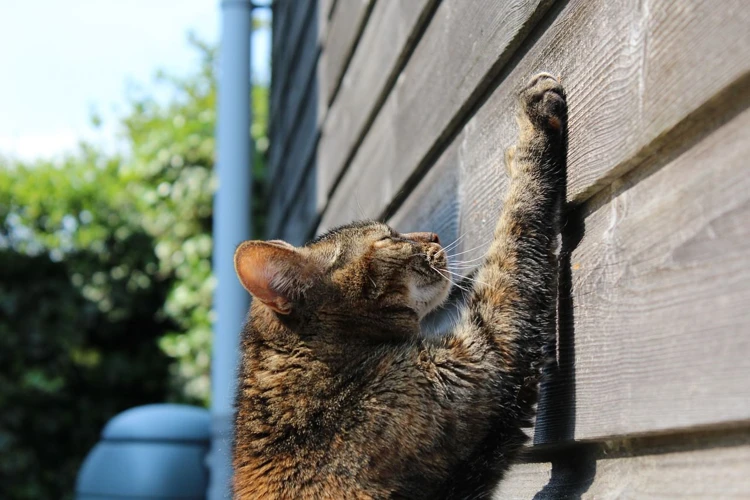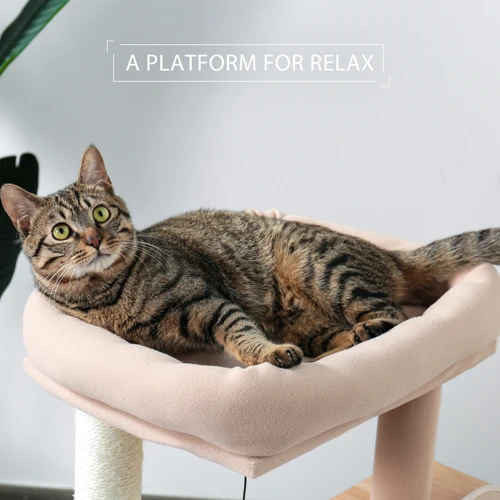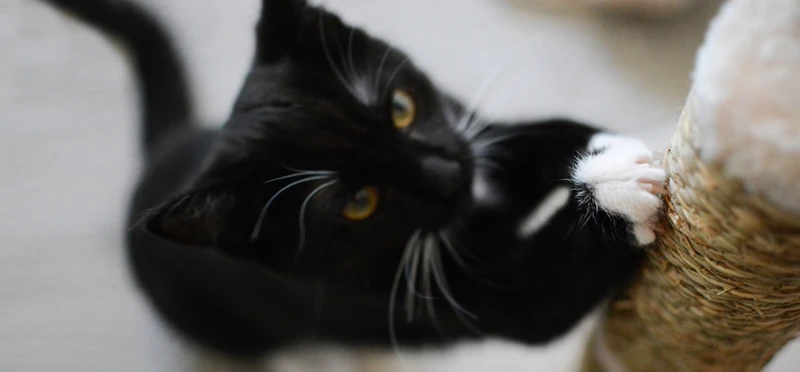As a cat owner, seeing your beloved California Spangled scratching your furniture can be a frustrating sight. Your mind might jump to purchasing a new couch or chair, but before you do, consider whether it might be possible to train your cat to stop scratching your furniture. With the right techniques and a little patience, you can redirect your cat’s scratching behavior and preserve your furniture. So, how exactly can you teach your California Spangled to stop scratching your furniture? Let’s explore some effective strategies below.
Understand Your Cat’s Scratching Behavior

Understanding your California Spangled’s scratching behavior is crucial to preventing them from damaging your furniture. Scratching is a natural instinct for cats, which is why it’s essential to understand why and when your cat scratches. By understanding their behavior, you can redirect their scratching behavior onto appropriate surfaces and protect your furniture. Not only will this save you money on furniture repair, but it will also keep your spangled happy and healthy. Let’s dive in and learn about why cats scratch and when they are most likely to do so.
Why Cats Scratch
Understanding why cats scratch is essential to train a California Spangled to stop scratching furniture. Scratching behavior is innate in cats, and it serves many purposes. As it scratches, it removes the dead outer layer of the claws, making way for newer and sharper claws. Additionally, it keeps the claws from becoming too long or too sharp and relieves any discomfort associated with the length of the claws.
Scratching is also a way for cats to mark their territory. The scent glands on their paws leave behind a unique smell that sends a message to other cats, saying, “I was here first.” Marking territory is an important aspect of cat behavior because it helps them establish and maintain dominance over their surroundings.
Scratching is an essential exercise for cats. Stretching and pulling against a sturdy surface helps them unleash the tension in their muscles, which otherwise could cause stiffness. It is recommended that cats get at least 30 minutes of exercise daily to maintain good health.
It is important not to punish a cat for scratching, as it is an innate behavior. Instead, provide the cat with appropriate scratching surfaces and train it to use them. Redirecting your cat’s scratching to suitable surfaces can save your furniture and strengthen the bond between you and your furry friend.
Internal html link: Californian Spangled Basic Commands
When Do Cats Scratch
Cats scratch to mark their territory, stretch their muscles, and sharpen their claws. Understanding the triggers for a cat’s scratching behavior can help in redirecting their scratching tendencies towards appropriate surfaces. When do cats scratch? Below is a table summarizing the different scenarios when cats tend to scratch and possible reasons for their behavior:
| Scenario | Possible Reasons for Scratching Behavior |
|---|---|
| Stretching | To stretch muscles and maintain flexibility, especially after a nap or long period of inactivity. |
| Marking territory | Cats scratch to mark their territory and release pheromones from their paw pads. Scratching is a form of communication with other cats. |
| Boredom or stress | Cats may scratch out of boredom or stress. Scratching can be a coping mechanism for stress or anxiety, and can help relieve tension. |
| Playfulness | Cats may scratch during playtime to release energy and excitement. |
Knowing the reasons behind a cat’s scratching behavior can help in determining how to redirect their scratching tendencies. For example, if boredom or stress is the trigger, providing a stimulating environment or incorporating interactive playtime could help alleviate their need to scratch inappropriately. Additionally, offering appropriate scratching surfaces and positive reinforcement can help encourage cats to scratch furniture less and use designated scratching posts more.
If you want to learn how to train your California Spangled using clicker training, read our guide: Clicker Training for California Spangled Cats.
Provide Appropriate Scratching Surfaces

After understanding why your California Spangled likes to scratch, the next step towards stopping the behavior is to provide appropriate scratching surfaces. Since your cat is going to scratch one way or another, having designated surfaces for this behavior is crucial. Not only does it give them an outlet for their natural instincts, but it also protects your furniture. Let’s take a closer look at what types of scratching surfaces your cat may prefer and how to introduce them properly.
Types of Scratching Posts
When it comes to providing appropriate scratching surfaces for your California Spangled, there are several types of scratching posts to choose from.
Vertical Scratching Posts: These are the most common type of scratching post and are perfect for cats who enjoy reaching up and stretching out. They can be made of a variety of materials such as carpet, sisal rope, or cardboard and come in different heights and widths. Get one that’s tall enough for your cat to fully extend their body while scratching.
Horizontal Scratching Posts: These scratching surfaces are perfect for cats who prefer to scratch while lying down or who like to scratch angled surfaces. They come in a variety of materials, including cardboard, sisal, and even wood.
Scratching Pads: These are small, flat boards covered with a scratching material, such as sisal. They can be placed on the floor or mounted on a wall and are perfect for cats who like to scratch horizontally.
Scratching Towers: These are multi-leveled structures with scratching surfaces on every level. They are perfect for homes with multiple cats who like to scratch and climb. Some scratching towers come with built-in toys and cubbies for your cat to play and hide in.
It’s important to remember that not all cats have the same preferences when it comes to scratching surfaces. You may need to experiment a bit to find which type of scratching post your California Spangled prefers.
Once you’ve found the right type of scratching post, make sure it’s sturdy and secure enough to support your cat’s weight and scratching force. A wobbly scratching post not only makes your cat feel unsafe but also poses a risk of falling over and causing injury.
Note: Training your California Spangled to use a scratching post takes patience and time. In the meantime, consider using temporary deterrents such as double-sided tape or aluminum foil to protect your furniture. You can also read our article on litter box training and check our guide on basic training to learn more about caring and training your special feline.
How to Introduce a Scratching Post
Introducing a scratching post to your California Spangled is an important step in redirecting their scratching behavior away from your furniture. Follow these steps to properly introduce the new scratching post:
| Step 1: | Find a suitable location for the scratching post. Cats like to scratch in areas where they spend a lot of time, such as near their food bowls or sleeping areas. |
| Step 2: | Encourage your cat to investigate the scratching post by placing treats or catnip on or near it. This will help create a positive association with the post. |
| Step 3: | Make the scratching post more appealing by rubbing catnip or a favorite toy onto the post. This will attract your cat to it and encourage scratching. |
| Step 4: | Show your cat how to use the scratching post by gently picking their front paws up and placing them on the post. Use positive reinforcement, such as treats or verbal praise, to encourage them to scratch the post. |
| Step 5: | Discourage your cat from scratching inappropriate surfaces by placing double-sided tape or aluminum foil on or near them. This will make the surfaces undesirable to scratch. |
Remember to be patient when introducing a scratching post to your California Spangled. Some cats may take longer than others to adjust to the new object, but with consistency and proper encouragement, they will learn to love their new scratching post.
Pro tip: Crate training is another important aspect of keeping your California Spangled happy and healthy. Check out our crate training guide for tips on how to do it effectively. If you want to get your cat outside more check out our Cal Spangled leash walking guide for a step-by-step guide on harness training.
Redirect Your Cat’s Scratching Behavior

Redirecting your cat’s scratching behavior can be a challenging, yet necessary task. As much as we love our California Spangled feline companions, we certainly do not appreciate when they ravage our furniture. Fortunately, there are ways to deter and redirect their destructive scratching habits towards more appropriate surfaces. With a bit of patience, consistency and the right methods, you can train your cat to scratch where it is allowed, and prevent furniture damage at the same time. Let’s explore some of the effective approaches that will create a harmonious living space for both you and your cat.
Deterrents for Furniture
If you want to teach your California Spangled to stop scratching your furniture, you must provide them with appropriate scratching surfaces and redirect their scratching behavior using deterrents for furniture. There are several effective ways to make your furniture unattractive for scratching, such as using double-sided tape, aluminum foil, citrus spray, and bitter apple spray.
Tape is an affordable and easy solution to deter your cat from scratching. You can use double-sided tape or clear packing tape on the areas where your cat likes to scratch. The sticky sensation is unpleasant for your cat, and they will quickly learn to avoid scratching that area. You can also use aluminum foil instead of tape, as cats don’t like the texture or sound of foil. Simply place strips of foil on the furniture to keep your cat from scratching it.
Another option is to use citrus spray or bitter apple spray, which are specially formulated to deter cats from scratching furniture. These sprays have a strong scent that cats find unpleasant and will avoid. However, before applying any type of spray to your furniture, test it on a small area first to make sure it doesn’t cause any damage or discoloration.
It’s important to note that while deterrents can be effective in stopping your cat from scratching furniture, they need to be used in conjunction with appropriate scratching posts. If your cat doesn’t have a suitable alternative, they will most likely continue scratching your furniture. Consistency is key when redirecting your cat’s scratching behavior, so make sure to reapply the deterrents regularly and provide your cat with plenty of positive reinforcement for using their scratching posts.
Positive Reinforcement for Scratching Posts
One of the most effective ways to redirect your California Spangled’s scratching behavior is to provide positive reinforcement for the use of the scratching post. Positive reinforcement means that you reward your cat for using the appropriate surface to scratch.
You can reward your cat with treats or toys that they love, or simply shower them with praise and affection. However, it is important to catch your cat in the act of using the scratching post and reward them immediately, so they associate the behavior with the reward.
To make sure your cat understands what they are being rewarded for, you can use clicker training. Clicker training involves using a clicker to make a distinct sound when your cat exhibits desirable behavior and then rewarding them immediately. It creates a clear understanding for your cat of what behavior is being rewarded.
Here is an example of how you can use clicker training and positive reinforcement to redirect your cat’s scratching behavior:
| Step | Action |
|---|---|
| Step 1: | Place a treat on top of the scratching post. |
| Step 2: | Wait for your cat to approach the scratching post. |
| Step 3: | As soon as your cat begins to scratch the post, click the clicker and give them the reward. |
| Step 4: | Repeat Steps 1-3 several times a day for a few weeks until your cat has developed a habit of using the scratching post. |
Remember to be patient with your California Spangled and reward them consistently. With persistence and positive reinforcement, your cat will learn to use the scratching post instead of your furniture.
Consistency is Key
Consistency is crucial when it comes to teaching your California Spangled to stop scratching furniture. Cats are creatures of habit and routine, so it’s essential to create a consistent training schedule and stick to it. Remember, it may take some time and patience to see results, so don’t give up if your cat doesn’t immediately take to the new scratching post.
Set up a routine that includes a regular training time, rewards for good behavior, and deterrents for bad behavior. Make sure everyone in your household is on the same page and follows the same rules regarding your cat’s behavior. Consistency will help reinforce the desired behavior and eliminate confusion.
Be patient and persistent. Learning a new behavior takes time, and your cat will need repeated practice to form a new habit. Don’t get discouraged if your cat goes back to scratching the furniture occasionally. Keep redirecting their behavior to the scratching post and rewarding them when they use it.
Monitor your cat’s behavior and adjust your training strategy as needed. If your cat isn’t responding to positive reinforcement, try a different type of reward, such as a different treat or toy. If your cat continues to scratch the furniture, try adding another scratching post in a different location or using a different type of deterrent.
Stick to the plan and don’t give up. Consistency is the key to success when it comes to teaching your California Spangled to stop scratching furniture. With patience, persistence, and a positive attitude, you can train your cat to use appropriate scratching surfaces and keep your furniture scratch-free.
Conclusion
In conclusion, teaching your California Spangled to stop scratching furniture may seem like a daunting task, but with patience and persistence, it is certainly achievable. Remember, scratching is a natural behavior for cats and it is important to provide them with appropriate outlets to express this behavior. By understanding your cat’s scratching behavior, providing appropriate scratching surfaces, and redirecting their behavior, you can successfully protect your furniture and maintain a healthy and happy relationship with your feline companion.
It is essential to establish consistency in these efforts. Consistency not only ensures that your cat understands the appropriate behavior but it also reinforces your role as the provider and protector. Make sure to reward your cat for using the designated scratching posts and provide deterrents for furniture. With time and positive reinforcement, your cat will learn to scratch appropriate areas without causing damage to your belongings.
Additionally, it is important to understand that every cat is unique and may require different approaches in addressing their scratching behavior. If you are experiencing difficulties, do not hesitate to seek the advice of a professional veterinarian or animal behaviorist who can guide you in developing an effective strategy for your particular cat.
Remember, teaching your California Spangled to stop scratching furniture is not only about preserving your belongings but also about nurturing a positive and healthy relationship with your cat. By taking the time to understand your cat’s behavior and needs, you can provide an environment that promotes positive scratching habits while still maintaining a comfortable and happy home for all.
Frequently Asked Questions
What if my California Spangled is already scratching the furniture?
It’s not too late to redirect your cat’s behavior. Follow the steps in this article to provide appropriate scratching surfaces and use deterrents on the furniture.
How can I tell if my cat is scratching due to anxiety?
Excessive scratching or destructive behavior can be a sign of anxiety. Consult with your veterinarian if you suspect this is the case.
What should I look for in a scratching post?
Look for a scratching post that is tall enough for your cat to fully stretch out and stable enough that it won’t tip over. Sisal, cardboard, or carpeted posts are good options.
Can I declaw my California Spangled?
Declawing a cat is an invasive surgery that can lead to long-term physical and behavioral problems. It is not recommended and is even illegal in some areas.
What should I do if my cat is still scratching the furniture even with a scratching post available?
Try using a deterrent such as double-sided tape or a motion-activated spray to deter your cat from scratching the furniture. Also, make sure that the scratching post is in a location that your cat prefers to scratch.
How often should I replace my cat’s scratching post?
Scratching posts should be replaced when the sisal or carpet becomes worn out or the post becomes unstable.
Can I make my own scratching post?
Yes! DIY scratching posts can be made using materials such as cardboard, carpet, or sisal rope. There are many tutorials available online.
Why is my California Spangled only scratching the furniture in one particular room?
Your cat may prefer to scratch in a certain location due to the texture or material of the furniture. Try providing a scratching post in that same location to redirect their behavior.
Should I punish my cat for scratching the furniture?
No, punishment can create a negative association with scratching and can lead to further behavioral problems. Redirect their behavior to appropriate scratching surfaces and provide positive reinforcement when they use them.
What if my California Spangled prefers to scratch horizontally instead of vertically?
Provide a scratching surface that allows for horizontal scratching, such as a cardboard scratcher or a flat scratching mat.







